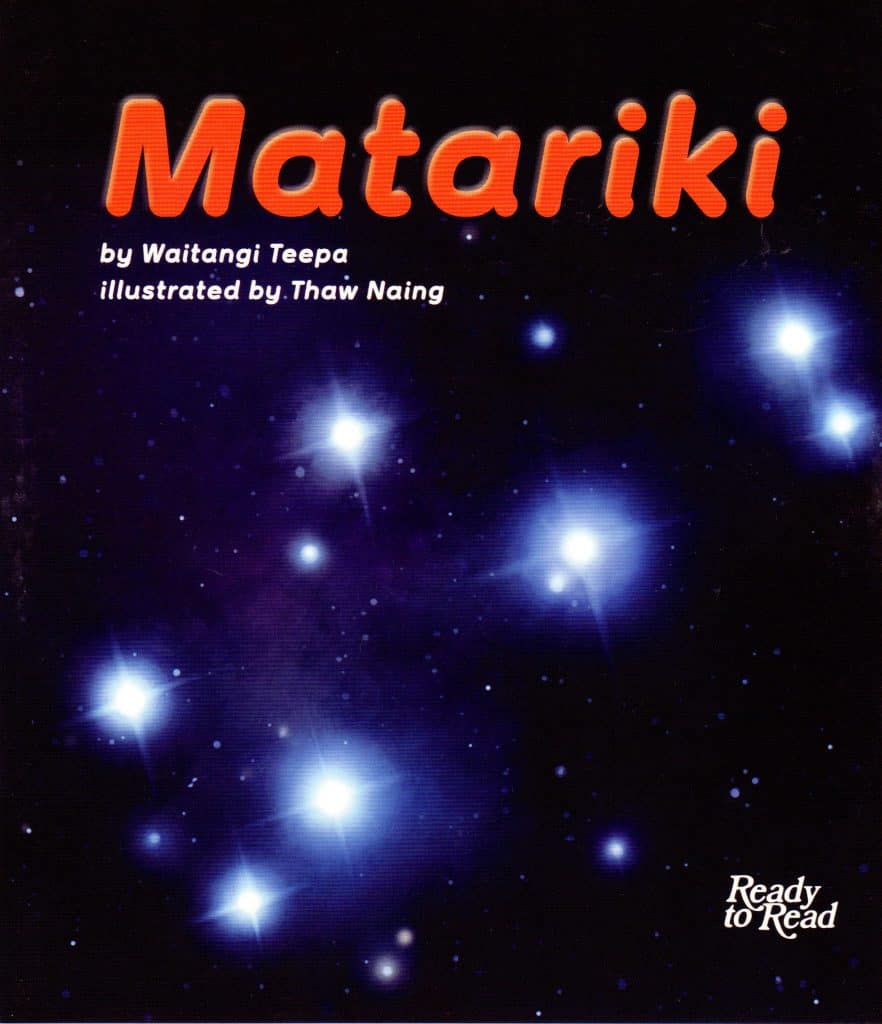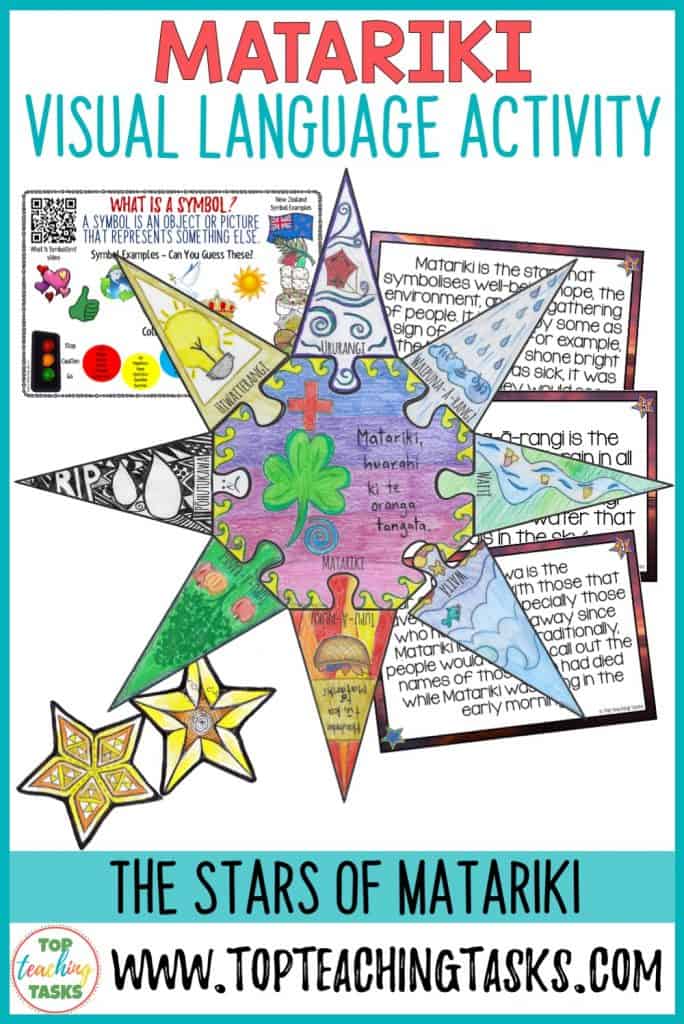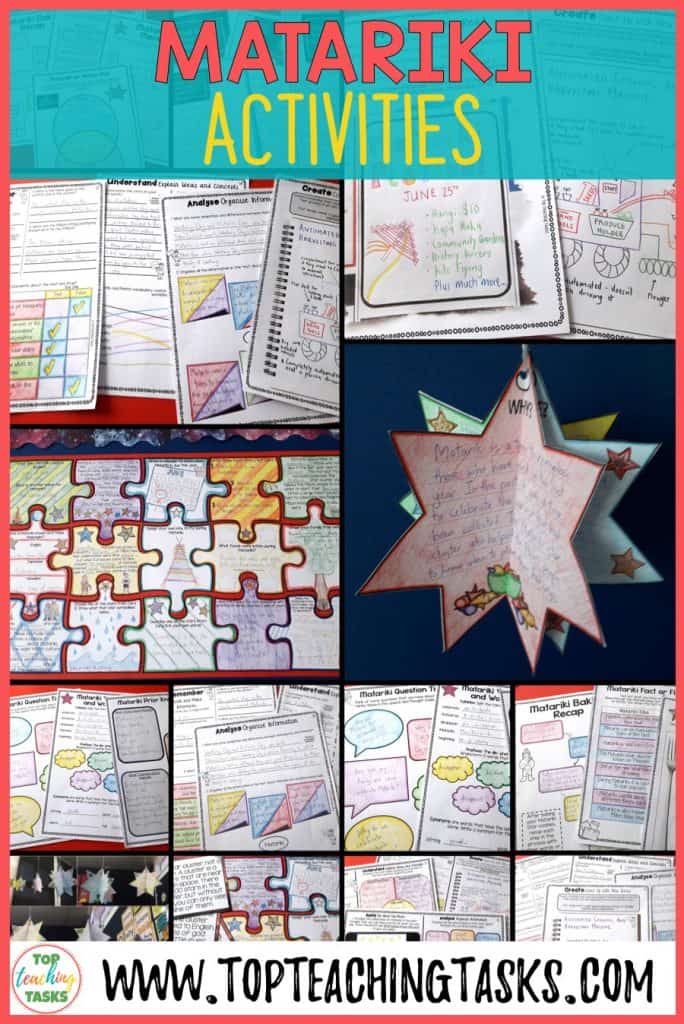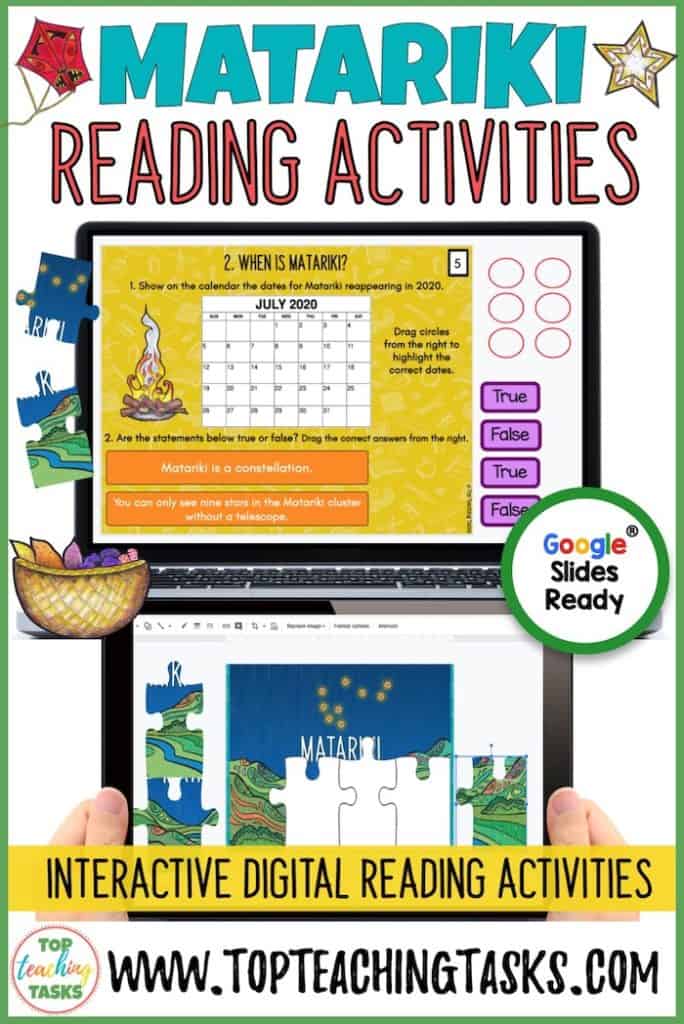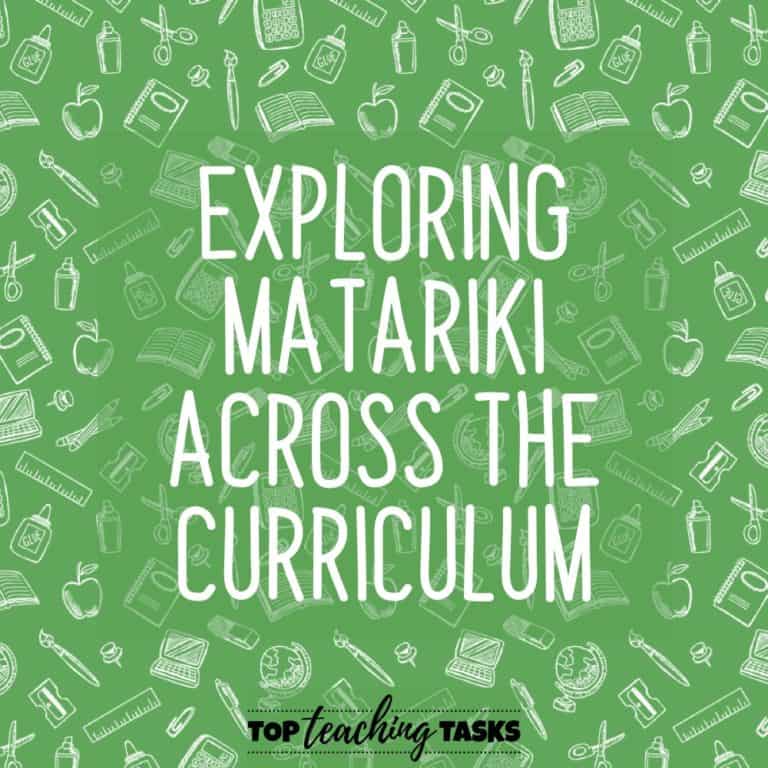5 Ways to Introduce Matariki
![The celebration of Matariki, the Māori New Year, has grown in popularity in recent years and there is a wealth of information and ideas out there to help you commemorate the event with your students. Read on to learn 5 ways to introduce Matariki in your classroom. Learn how to use Matariki activities for kids and Matariki resources, check students prior knowledge and upskill in your own professional knowledge of Matariki. [Matariki stars] The celebration of Matariki, the Māori New Year, has grown in popularity in recent years and there is a wealth of information and ideas out there to help you commemorate the event with your students. Read on to learn 5 ways to introduce Matariki in your classroom. Learn how to use Matariki activities for kids and Matariki resources, check students prior knowledge and upskill in your own professional knowledge of Matariki. [Matariki stars]](https://topteachingtasks.com/wp-content/uploads/2019/04/5-ways-to-introduce-Matariki-682x1024.jpeg)
The celebration of Matariki, the Māori New Year, has grown in popularity in recent years and there is a wealth of information and ideas out there to help you commemorate the event with your students. Read on to learn 5 ways to introduce Matariki in your classroom.
What is Matariki?
- Matariki is the Māori name for the small cluster of stars also known by a variety of other names, such as the Pleiades. The name Matariki, translated to English, means the ‘eyes of the god’ (mata ariki). Matariki is also known as the Māori New Year.
- The dates of Matariki are based on the Māori lunar calendar. This means that the date of Matariki changes each year. In 2023, from the 10th-13th of July, Matariki will re-appear in the dawn sky – signalling the start of the Māori New Year.
- Matariki is a special time for the Māori people of New Zealand and it is growing in popularity as a festival for all New Zealanders.
- Matariki is now a special public holiday in New Zealand. In 2023, this will be held on Friday, 14 July.
5 Ways to Introduce Matariki
There is a lot of information available about Matariki, which can be a blessing and a curse. The challenge for busy teachers then becomes sorting through this information and deciding how to teach the celebration of Matariki in the classroom. To save you time, I have sourced a range of ideas and resources to save you time and ensure you are ready for a great Matariki.
Even if you have never taught Matariki in your classroom before, I challenge you to keep reading and see if there is something that piques your interest – you may be surprised!
1. Share videos to introduce concepts of Matariki
What kid doesn’t like the excitement of sitting down to watch a movie? There are a lot of great introductory movies and short films that explain the concepts of Matariki, and I have highlighted a couple below with some explanation as to why I think they are essential viewing.
Title: Matariki [Ngā mata o te ariki, o Tāwhirimātea: The eyes of the god, Tāwhirimātea], Running Time: 3:23
This short video tells the pūrakau (Māori Myth) of Ngā mata o te ariki, o Tāwhirimātea, one origin story of the Matariki stars. I love, love, love the visuals in this video, and the story is told in a clear and creative way.
- One way you could integrate this into your classroom programme is to provide students with a series of comic strip boxes or a flow diagram with empty boxes. Show the video to your students and get them to write or draw the pūrakau through their graphic organiser.
- This video is narrated in te reo Māori with English subtitles. This makes it a wonderful way to bring te reo Māori into your classroom as well as providing a reading comprehension exercise. Hint: sit close to your computer when presenting this video so that you can pause the video at times – the subtitles do change quite fast.
Title: Matariki Waiata (Song), Running Time: 0.31
A great way to introduce the concept of Matariki is through waiata (song). Thanks to Sara Rich for the recommendation.
Another great source of videos about Matariki is NZ on Screen. You can find their Matariki collection here.
2. Explore Matariki through shared reading
![The celebration of Matariki, the Māori New Year, has grown in popularity in recent years and there is a wealth of information and ideas out there to help you commemorate the event with your students. Read on to learn 5 ways to introduce Matariki in your classroom. Learn how to use Matariki activities for kids and Matariki resources, check students prior knowledge and upskill in your own professional knowledge of Matariki. [Matariki stars] The celebration of Matariki, the Māori New Year, has grown in popularity in recent years and there is a wealth of information and ideas out there to help you commemorate the event with your students. Read on to learn 5 ways to introduce Matariki in your classroom. Learn how to use Matariki activities for kids and Matariki resources, check students prior knowledge and upskill in your own professional knowledge of Matariki. [Matariki stars]](https://topteachingtasks.com/wp-content/uploads/2019/04/Slide05-1-682x1024.jpeg)
Shared reading is a great way to:
- Build a love for reading,
- Introduce books that not all students could read independently (inclusion – woop woop!),
- Begin a class discussion about what Matariki means to your students.
The Ministry of Education has published some great shared reading and small group reading material to introduce Matariki in your classroom. A hunt through your school or public library will also highlight the range of picture books and short non-fiction books that you can use to get students thinking about Matariki.
The following two books should be available in your school resource room, and if not, you can order them here.
- Both these books are tailored for the younger levels, but due to the range of historical and cultural concepts discussed and the use of Te Reo Māori, I think they work well for upper primary also.
We have put together a series of activities to help in the comprehension of the Gold level reader, Matariki by Waitangi Teepa. You can find these activities here.

The story Matariki Breakfast comes with a large book for shared reading and a set of smaller books for individual re-reading. It tells the story of a family preparing breakfast to celebrate Matariki. In addition, it weaves throughout one myth about the Matariki stars. We have created a set of FREE activities to help your students understand this text. Click here to download this free resource.
3. Build engagement through Matariki Art
![The celebration of Matariki, the Māori New Year, has grown in popularity in recent years and there is a wealth of information and ideas out there to help you commemorate the event with your students. Read on to learn 5 ways to introduce Matariki in your classroom. Learn how to use Matariki activities for kids and Matariki resources, check students prior knowledge and upskill in your own professional knowledge of Matariki. [Matariki stars] The celebration of Matariki, the Māori New Year, has grown in popularity in recent years and there is a wealth of information and ideas out there to help you commemorate the event with your students. Read on to learn 5 ways to introduce Matariki in your classroom. Learn how to use Matariki activities for kids and Matariki resources, check students prior knowledge and upskill in your own professional knowledge of Matariki. [Matariki stars]](https://topteachingtasks.com/wp-content/uploads/2019/04/Slide06-682x1024.jpeg)
Now that your students have some understanding of Matariki, a fantastic way to build engagement (and brighten up your classroom) is through art. I’ve linked to some great Matariki art ideas below.
Important note: The key to making art purposeful as an introduction to Matariki is to ensure that you relate your activities back to Matariki. For example, why kite flying has significance during Matariki, how kākahu are used in Māori traditions, what we know about the Matariki stars.
![The celebration of Matariki, the Māori New Year, has grown in popularity in recent years and there is a wealth of information and ideas out there to help you commemorate the event with your students. Read on to learn 5 ways to introduce Matariki in your classroom. Learn how to use Matariki activities for kids and Matariki resources, check students prior knowledge and upskill in your own professional knowledge of Matariki. [Matariki stars] The celebration of Matariki, the Māori New Year, has grown in popularity in recent years and there is a wealth of information and ideas out there to help you commemorate the event with your students. Read on to learn 5 ways to introduce Matariki in your classroom. Learn how to use Matariki activities for kids and Matariki resources, check students prior knowledge and upskill in your own professional knowledge of Matariki. [Matariki stars]](https://topteachingtasks.com/wp-content/uploads/2019/04/Matariki-Art.jpg)
- Nat Gets Nifty is a teacher from Northland who has an amazing blog highlighting various artwork created in her classroom. She has various Matariki art activities that I highly recommend checking out. In fact, her entire site is brilliant if you ask me!
- Melulator has put together a step by step guide explaining the fantastic Matariki art that her class completed in 2018. This includes:
- Matariki stars
- Karearea bird feather art
- Matariki weaving
- The blog DIY Thought has put together a list of six Matariki star crafts. You can find these here.
Check out our Matariki Pinterest Board for more interesting art ideas!
Explore Matariki through Visual Language
We have put together a visual language and visual arts resource that focuses on symbolising attributes of the nine Matariki stars. Through this activity students:
- Learn about each of the nine Matariki stars
- Develop an understanding of symbolism and the use of symbols
- Use symbols, words and phrases to create their own Matariki star
- Explain how they symbolised each Matariki star
- Self-assess their finished artwork and written explanation
Click here to learn more about this resource.
4. Identify students’ prior knowledge of Matariki
![The celebration of Matariki, the Māori New Year, has grown in popularity in recent years and there is a wealth of information and ideas out there to help you commemorate the event with your students. Read on to learn 5 ways to introduce Matariki in your classroom. Learn how to use Matariki activities for kids and Matariki resources, check students prior knowledge and upskill in your own professional knowledge of Matariki. [Matariki stars] The celebration of Matariki, the Māori New Year, has grown in popularity in recent years and there is a wealth of information and ideas out there to help you commemorate the event with your students. Read on to learn 5 ways to introduce Matariki in your classroom. Learn how to use Matariki activities for kids and Matariki resources, check students prior knowledge and upskill in your own professional knowledge of Matariki. [Matariki stars]](https://topteachingtasks.com/wp-content/uploads/2019/04/Slide07-682x1024.jpeg)
I have previously blogged about the importance of identifying students’ prior knowledge in a recent Anzac Day post. To help you to clearly assess your students’ prior knowledge of Matariki, I have created a FREE Prior Knowledge Matariki display heading resource. Most teachers will be creating some kind of display to highlight the learning journey of your students’. I think this unique puzzle, spelling out the word MATARIKI through 35 puzzle pieces, is pretty special!
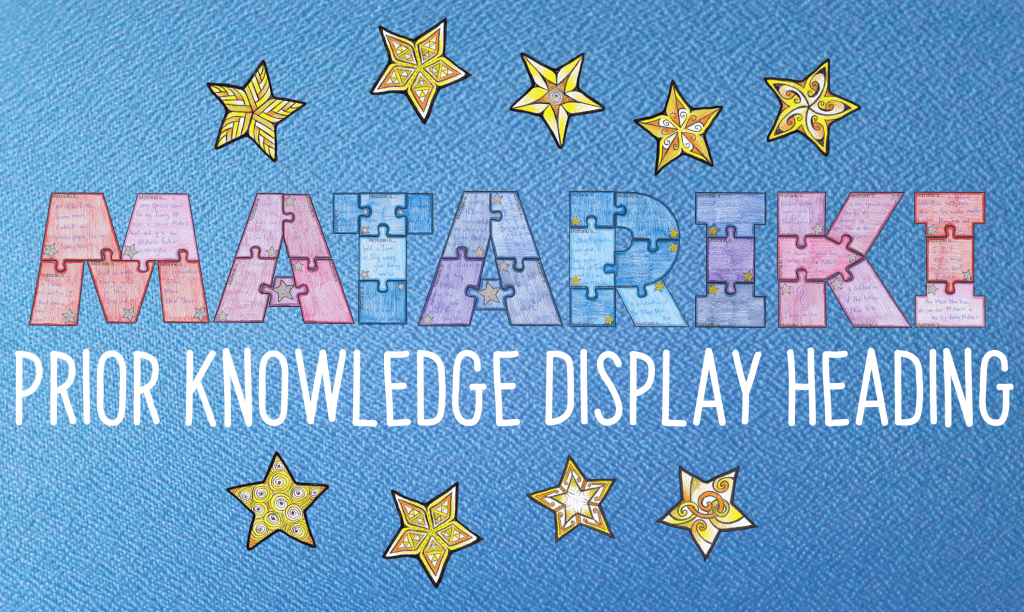
The purpose of this resource is to provide an interactive and engaging way to discover and present your students’ prior knowledge about Matariki. Once you have this heading displayed, you can visually show the growth in your students’ knowledge and understanding of Matariki and easily revisit their prior knowledge.
You can find our free Matariki Prior Knowledge Display Heading in our freebie library.
5. Upskill your personal Matariki knowledge
![The celebration of Matariki, the Māori New Year, has grown in popularity in recent years and there is a wealth of information and ideas out there to help you commemorate the event with your students. Read on to learn 5 ways to introduce Matariki in your classroom. Learn how to use Matariki activities for kids and Matariki resources, check students prior knowledge and upskill in your own professional knowledge of Matariki. [Matariki stars] The celebration of Matariki, the Māori New Year, has grown in popularity in recent years and there is a wealth of information and ideas out there to help you commemorate the event with your students. Read on to learn 5 ways to introduce Matariki in your classroom. Learn how to use Matariki activities for kids and Matariki resources, check students prior knowledge and upskill in your own professional knowledge of Matariki. [Matariki stars]](https://topteachingtasks.com/wp-content/uploads/2019/04/Slide08-682x1024.jpeg)
In the last couple of years, Māori star astronomers such as Waikato University Professor Dr Rangi Matamua have presented new research on Matariki that provides fascinating reading. As teachers, we are responsible for ensuring students understand this new knowledge. In addition, I have ensured that our Matariki resources include this up-to-date information
I highly recommend Matamua’s book “Matariki: The Star of the Year”. I found this to be an easy to read, practical and thought-provoking book; not full of academic mumbo jumbo! Since this book was published in 2017, I have updated my Matariki resources to include this up-to-date research.
Four interesting tidbits I learned were:
- There are actually nine, not seven, Matariki stars that are visible: Matariki, Tupu-ā-nuku, Tupu-ā-rangi, Waitī, Waitā, Waipuna-ā-rangi, Ururangi, Pōhutukawa, and Hiwaiterangi
- The Matariki star cluster is visible for most of the year, except for a month-long period prior to Matariki being celebrated.
- The translation by some of Matariki as “little eyes” is seen as more of a literal translation of the word Matariki than an interpretation with connection to Māori and their understanding of cosmology. The most common translation of Matariki is the “eyes of the God”.
- Myths of Matariki and her six daughters or Matariki as the seven sisters are likely to have originated from Greek, rather than Māori, myths.
Every page of this book is fascinating! Search it out in your local library, or even better, get your own copy that you can read more than once!
You can also learn more about Dr Rangi Matamua’s research through the video below.
Title: EIT Public Lecture – Dr Rangi Matamua, Running time: 41.19 minutes
Our Matariki Resources
We have a great range of Matariki resources that will build on the introduction of Matariki.
You can find our full range here.
We have a great range of Matariki resources that will build on the introduction of Matariki.
You can find our full range here.


